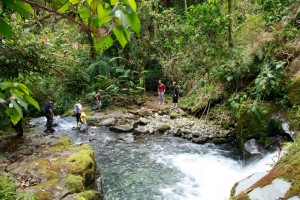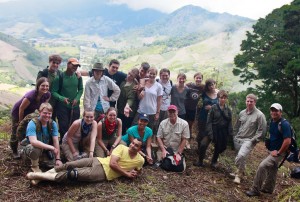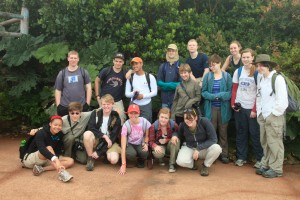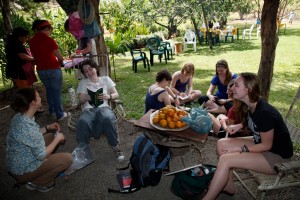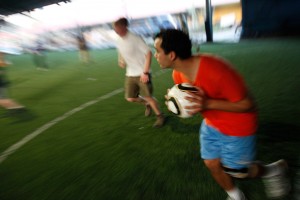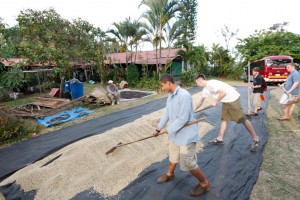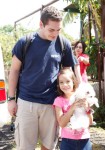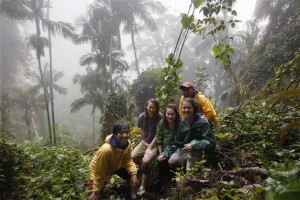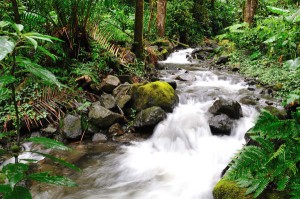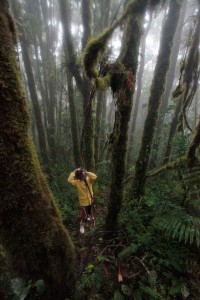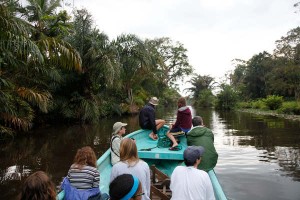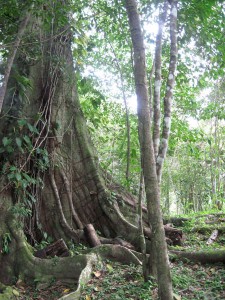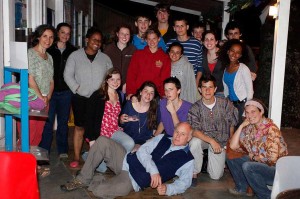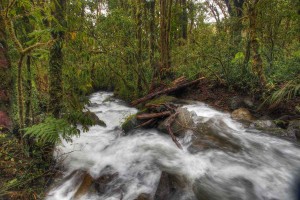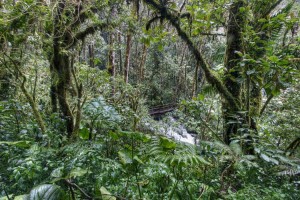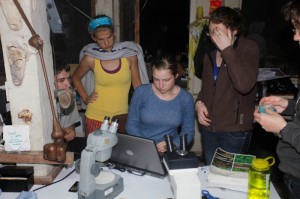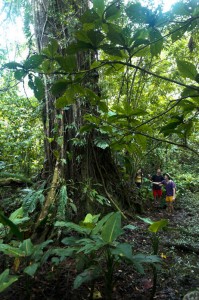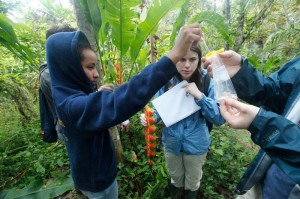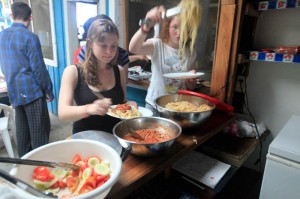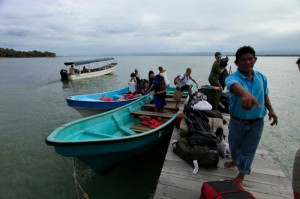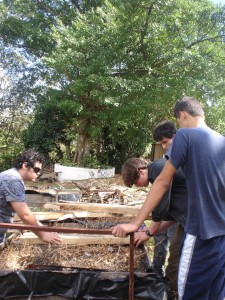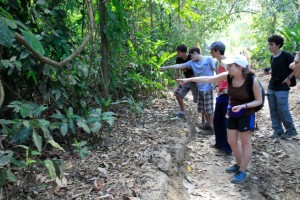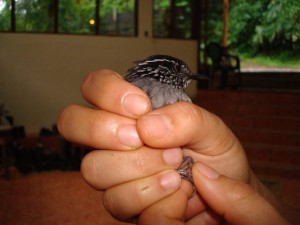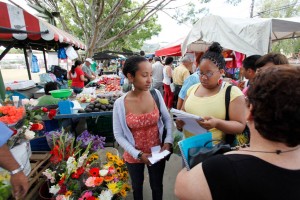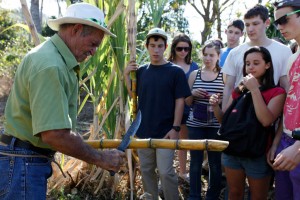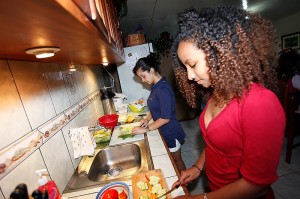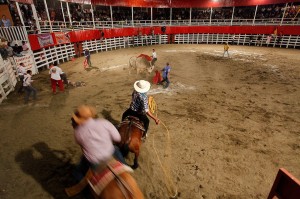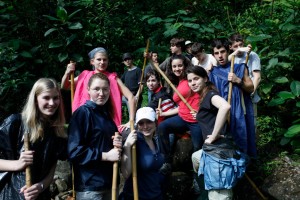Hi we’re in the San Jose airport. We through security and waiting at the gate. The flight is on time and we should be boarding in about 1/2 hour. See Itinerary below.
Lv San Jose, CR, USAir #1706, 3:35pm Ar Charlotte, NC 8:38pm (1 hr. time change)
Go through Customs in Charlotte
Lv Charlotte USAir #1538 10:10pm, Ar Boston March 10th 12:16am
Were in the San José airport
Expectations for students for Thursday and Friday
We do not expect students to go to school on Thursday. We encourage them to sleep in and to try to get some rest. Students may come in during the afternoon if they wish, but we ask that they be mindful that other students are in classes. We will reconvene A-block in Bio 1 on Friday, and we expect all to be there for the course of the day. There are a variety of course-end loose ends to tie up. We will plan, coordinated with the students, a productive but light and varied day. My cell phone (508-308-6900) will be active once we are in Charlotte.
Last full day in Panama
All is well and we’ll be on our way home tomorrow. It’s been a long time since we’ve had any extended access to internet. When I glance through the topics of the long list of unread emails, I realize it’s been as much as luxury as liability to not have email access for our time at Boca del Drago and at Cerro Punta. Nevertheless, I was sad to not be able to give daily updates and photos to those interested.
It’s been a very rich experiance for all of us as students have interwoven investigative science, natural history, ecology, animal behavior, culture, climate change, land use, economics, Spanish language, and group living. We’ve been supported along the way by many persons. Dr. Peter Lahanas was with us every day at ITEC and he had many ongoing discussions with students. Carlos Fonseca, who lives in nearby Volcán joined us full time in Cerro Punta. While Carlos has great knowledge of the local flora and fauna, and he facilitated our visits with local farmers, he also plays the guitar and sings very well. He was spot on with his slightly over the top rendition of “El Guerrero” (The Warrior) dedicated to Juan at his half birthday party. Other guides, farmers, biologists have been very helpful as well.
It’s too much at this point to try and recap all we did. We can say that, overall, the student projects at ITEC were the best we’ve ever seen. They pushed through statistics and full writeups. Students took advantage of opportunities to stretch and try new things. They were tired at times, but it was they that were doing the pushing, either to finish something well or try to squeeze in a new experience. There is much more that could be said about ITEC but time does not permit it now.
At Cerro Punta (Los Quetzales) we tried to relax the schedule a bit, and still students worked hard on individual initiatives such as mapping out puma tracks, photographing humming birds, writing, poetry, camouflage in the cloud forest, photographing up in the canopy with using a ground based rope system, writing a song, dress designs inspired by cloud forest flora, learning to cook, birding and bird lists, drawing epiphytes, photographing orchids, dance, and specific survival techniques for the cloud forest.
We also took daily hikes, visited local farms, examined land use practices, compared the forests that we have seen in Costa Rica and Panama, and discussed climate change. It’s been a busy but rewarding month. There will be more time later for some final comments about the course. It’s time to finish up some course loose ends and to pack for our long travel day.
Breakfast will be ready at 6 am. We hope to be off to David tomorrow for a 10:30 flight to San San Jose, Costa Rica. There we will have to clear customs and then recheck our bags for US Airways flight thorough Charlotte, NC to Boston. See “Itineraries” for details. As we are now digitally connected to the world, we should be able to give you some brief updates (probably through email). I expect to see some of you in Boston.
The Cloud Forest
It’s been a long time since I’ve had a chance to blog, I have a very short time to do so now. I am pleased to see the the student entries, see http://blogaboutmonkeys.blogspot.com/ and http://wfreedberg.tumblr.com/. Read them to get more flavor of our stay with ITEC at Boca del Drago. Everyone is settled into four cabins set deep in the forest. We seperated into 3 groups and took orientation hikes in the forest. The food is great. We all eat in one cabin, where a cook, with some student help, cooks us locally grown food. At night we settle back into our cabins where woodstoves take the chill out of the air. Students are working together to make this last site a satisfying finish to the course. We are tieing many threads together here while leaving time for contemplation and individual initiatives. Thats all I have time for right now. I hope to give you nanother update in a day or two.
Los Quetzales
We made it to Cerro Punta. As I type, half of the group is being transported up the mountainside to their cabins and the rest of us will soon follow. Our journey here went pretty smoothly, despite a little boat motor troubles and being caught in a bit of a rainstorm on the water. It’s time for my group to head on up and eat a delicious dinner of locally grown foods! We may be able to write again in a day or two. Hasta Luego!
Last day in ITEC
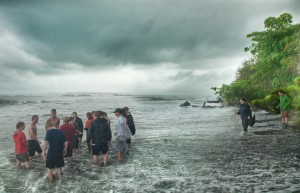 Hello! Check out the new entries on the student blog.
Hello! Check out the new entries on the student blog.
Today is our last full day at ITEC. Tonight we have the group science project presentations. Tomorrow we leave around 7am to take the boats from Isla Colon to Almirante. From there we load our gear onto a bus and drive to David. We will buy breakfast food to bring up to the cabins and then head the rest of the way climbing up the winding roads in to the cloud forests of Los Quetzales in Cerro Punta.
Our cell phones should work there — though reception can be a little spotty. We will have limited access to internet.
Contact numbers and Student blog
Here are our cell phone numbers if you need to call:
Dial: 011-507 and then…
Steve: 64295365
Juan: 69293353
Amber: 69293354
Check out some new student blog entries:
Student blog
ITEC adventures
Hello again!
All is going well. I am in town for the part of the day with the several students who are conducting interviews for their project about the use of plant-based/home remedies and modern medicine. Yesterday morning it was raining hard, so we tucked into the cover of the ITEC lab and library to do background research for the science projects, further develop our experimental methods, and gather and prepare supplies.
We’ve been modifying the projects as needed due to the weather. The rain let up a bit in the afternoon so some of the coral reef based groups headed out to see if they could start to gather data. Jesse and Jeff dove in and took some underwater movies of different quadrants of coral, with an occasional moment of high wave action that rocks and sweeps the brave cameraman! These two along with Sarah, MJ, Niko, and Tilly who are eager to study sea urchin distribution, and took the boat with Enrique and Juan to another coral reef area “Pete’s reef” near a river outlet by the mangroves. The group made a valiant effort to run their transects and collect data, but the run-off from the river made the area too turbid and close encounters with the spiny urchins a little bit too close for comfort. So, today they will investigate looking into the movement patterns of another echinoderm, perhaps the cushion star or another species of sea urchin which hides in little nooks in the rocky intertidal areas.
The group studying leaf cutter ants, Kate, Peter and Briana found some great colony mounds to study and completed a little preliminary experiment. We are crossing our fingers that the rain will let up tonight so there will be enough ant activity to observe.
The gecko group, Alex, Will, Aundre and Amelia set up their sugar experiment after much pounding of nails to secure plastic cups full of different concentrations sugar on the station walls and they will continue to observe these four sites in the following evenings. Amelia and Steve are also jumping into wilds of micro-photography, creating some amazing pictures of pollen grains and discovering special nectaries on the Noni fruit that attract pollinators. (photos to come soon we hope!)
Despite the rain a brave group trekked out last night for two hour night hike along the coast and back into some primary forest, bringing back stories of red-eyed tree frogs and caymans among other cool night creatures. Another group of us stayed a bit more dry (the roof was leaking in some spots) inside the classroom and watched a documentary”Se quema el cielo” about protecting and managing fires in the Guanacaste Conservation Area. In the next couple of days we will continue with the group projects, visit nearby caves, and take a trip along the canal that runs all the way to the Changuinola River from the Serrapta Pennisula. You can see the canal cut if you zoom in on this google satellite map
Check out some new student blog entries:
Student blog
Settling in to ITEC
We’ve arrived! In the last couple days we have been settling into the ITEC field station, and becoming oriented to the area by hiking through primary lowland rainforest, snorkeling in a cove with coral reef and mangrove, and we will soon begin developing the group science projects. Everyone is doing quite well and adjusting to the muggier climate, the bugs and the new bunk accommodations fully equipped with mosquito nets, stream water pipped into the showers, and a filtration system for our drinking water.
Travel to Bocas del Drago went fairly smoothly, just a bit of a delay at the Panamanian border. After a flurry of making another set of photocopies of our passports (first time we have been asked to leave these with the border office) and then another hour and a half of waiting for the woman who issues bus insurance to return from her lunch, we were very relieved to be out of the intense pounding sun by the border town surrounded by banana plantations. We continued on for another hour in the bus (after about the 6 hour ride to get to the border) and finally met up with Pete Lahanas, who directs ITEC, and loaded into the boats in Almirante to across over to Isla Colon. The water was choppy and with all the baggage so our crossing was quite slow (we even had to have another small boat come take some of the gear.) It’s great to see Pete, Enrique and Enrique Sr. again as they navigate the boats past the mangrove covered islands. We arrived just before dinner time at Bocas Del Drago, and were soon setting ourselves up in beach cabins bunk rooms.
The next day we had a wonderful orientation to the “forbidden forest” a bit of lowland primary forest where we walked beneath the canopies of trees that were about 5-6 students in circumference and passed by plants that are able to survive in the low light of the forest floor and evolved in the jurassic period with sharp silica in their leaves to ward off herbivory by dinosaurs. We also encountered many poison dart frogs, rain frogs, borrowing fish in a temporary stream, newly forming ant colonies, wasp nests, morpho butterflies, helicopter damselflies, and a vine snake that has a laterally compressed body shape which allows it to stretch across from tree to tree.
In the evening the students rotated through three science stations to deepen our understanding of the scientific process, like developing a null hypothesis, looking for correlations of statistical significance and testing out a population estimate equation.
Our access to email is very limited we must travel into town since in is not available at the station.
In case you need to reach us, you can call Pete: 011-507-6853-2134.
We are still in the process of getting the course cell phones set up and we will soon post those.
La Despedida y Vamos a Panama
I (Steve) added some photos at the last minute: despedida
I am sitting on the porch of Isabel’s house after a delightful evening with our Spanish teachers and our families. We had a festive graduation ceremony to mark the completion of 32 hours of Spanish classes. The students gave wonderful presentations to demonstrate what they learned using poetry, theatre, and puppetry. Will and Sarah spoke eloquently on behalf of all the students to thank the families for opening up their homes and hearts. Each student gave a hand written and decorated card and flowers to their families and to their teachers. Isabel’s backyard came alive with the sounds of children’s laughter and live marimba music, the smells of huge pots of arroz con pollo and grass under running feet, the colors of haikus hanging on the clothes line and the whirling shirts of dancing people and swinging hammocks.
Tomorrow we will meet in the central park at 5:30am to load up the bus and head to Panama. Our journey will take us through Braulio Carrillo National Park and then down along the coast through agricultural lands with many Banana and Palm oil plantations, on the way to the the border. It will get much greener as we near the coast. Most of this lowland rainforest. We will arrive at Almirante around 3 or 4 in the afternoon where we will meet up with Pete Lahanas and take 45min boat ride to Isla Colon.
We have to go. we will do our best to keep you informed.
Last day in Atenas
Click for Photos of UTN and more: UTN (Unversidad Tecnica Nacional)
This is our last day in Atenas. I’m going to the airport shortly to pick up Carra Cheslin. We’re excited to have Carra join us as a teaching intern and group leader. She’s made arrangements with her professors at Connecticut College, so that she can part of the course.
Juan and Amber are making many arrangements for our final day, including the “despidida.” or farewell and thank you party. Our visit to UTN went very well. The person who gave us a lecture on waste management and recycling was a homestay father of one of our students in 2009. He spoke slowly and clearly, and he good visuals. He was a good speaker and engager. After the lecture we toured UTN’s animal husbandry projects. We saw goats, sheep, cows, crocodiles, iguanas, composting, and biogas generation. It was great. Students will regroup for final classes, graduation, and then the despidida. It’s looking like our Internet capabilities will be very limited in Panama. Wireless Internet has not matured as promoted by companies in Panama. While there is an outside chance we might have some limited Internet. we likely will have to go into town (an hour away) to use the internet or upload photos. We are looking at various strategies for posting, but it will much more limited. Nonetheless, students will be able to call home. We will have cell phones that students can use with a prepaid phone card. I will post more about communication, including phone numbers on separate page that you can access on the website header.
More than a trip
I can’t believe it is almost time for us to leave Atenas (and Costa Rica) and embark into our new adventure; Bocas del Toro, Panama. Before we leave, I would like to share some of my thoughts about our time here, in my hometown and home country. I have to say that this has been one of the most rewarding experiences in my professional career. Although past courses, either in Costa Rica – Panama or Belize – Guatemala, were academically rich and intense, this one has been special. Perhaps it is because the students have worked hard every day (including weekends) or that they are extremely interested in the culture and all the learning experiences that they are exposed to every day. I really enjoy sharing my culture and language with all of them.
It has been an amazing experience for all of us here in Costa Rica. This is the ultimate “integrated studies” course any student at CSW can take. Today, the students completed a social science exercise in which they had to interview their host family about recycling in Atenas. Obviously, that interview was conducted in Spanish! What a treat. Tomorrow the students will have the opportunity to learn more about waste management in the country and particularly in Atenas when we visit the Universidad Tecnica Nacional (National Technical University). Salud!
I would love to write more about this amazing experience, but there is a lot more to be planned still. Panama here we (almost) go.
Last Days in Atenas & Panama
We are nearing the end of our time in Atenas. Yesterday we had Spanish classes in the morning, and in the afternoon, three groups of students collected continued initiatives to find out more about recycling in Atenas. One group polished and translated a survey to be asked of the homestay mothers, another interviewed some key persons in town, and the final group made observations in the central park. In the evening most students headed to the MuliPlaza Mall, where we watched “Temple de Acero” (True Grit) or “127 horas.” Some stayed with Amber for the final day of the Fiestas. Alex played played soccer in the field by Sabana Larga. Our final day in Atenas is tomorrow. In the morning we will go the Universidad Tecnica Nacional. We will have a tour of some the animal husbandry projects and then a lecture on waste management. In the afternoon, after our final classes, we will have a “graduation” from Isabel’s Language School followed by a small celebration with some of the host families. We will leave very early the next morning (~6 am) for our bus ride to Panama. We will enter Panama on the Caribbean side. More tomorrow on our Thursday travel day and anticipated communication possibilities at ITEC.
We are starting to prepare students for Panama. As in Santa Rosa, we will be in dorm rooms on very small “campus.” Having the group living together again will have it’s benefits and challenges, and we will be working with the students to make the transition. The site is striking. We are immediately adjacent to the ocean, and there are coral reefs immediately offshore. We are in a lowland rainforest area, and areas of forest are interspersed with settled areas. This part of Panama is poorer than what the students have seen so far. Many people raise cattle, chickens, geese, and have fruit trees and small gardens. We are staying in Institute for Tropical Ecology and Conservation facilities. This is a pretty basic, old-fashioned, field station. There is no air conditioning or hot water. We will need mosquito nets at nights, and it may be hot and muggy for sleeping. Electricity is by generator. There are small sand flies in the area. While they are not disease vectors, nor is their bite very painful, cumulatively they can be irritating. We will take measures to reduce bites and discomfort for those sensitive.
We will have breakfast and lunches at ITEC and suppers at nearby Yarisnori’s Restaurant. Both Yarisnori and ITEC have excellent health standards. When we go into town (only 8 miles but about and hour away) have health standards are less consistent and we will be advising the students on how to stay healthy. Overall, In terms of health concerns, there have been few so far but we are bound to have some before the course ends. Juan, Amber and I have been to this site multiple times. In addition, Carra Cheslin, a student in our ’07 couse, will be with us. We will do our best foresee and manage health and safety concerns.
We will be joined in Panama by Dr. Peter Lahanas. “Pete” is the director of ITEC. His specialty is herpetology and animal behavior. He has produced leading research on the variance of color morphs in Dendrobatus pumilo (a species of Poison Dart Frog) on different islands in the archipelago of Bocas del Toro. All-in-all it’s an exciting, varied and rich site. I point some of the challenges of the site so that you and the students are prepared. It should be an exciting and fulfilling adventure.
Fiestas in Sabana Larga & Poas visit
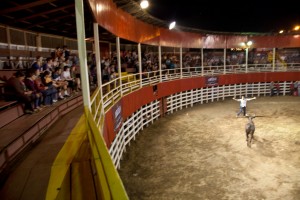 On Saturday evening we went to the “Fiestas de Sabana Larga,” Click on Fiestas to see photos. This a four day event. There was abundant food, dancing, and mingling with locals. We went on the first day that they had rodeo events. The bull riding was similar to US rodeos, but there were aspects you would not find in a US rodeo. One of these is where locals collectively “dare” smaller bulls by running through the ring. Those putting themselves in most apparent danger get positive feedback from the crowd. Our students did not participate! All the students enjoyed one aspect of the Fiesta or another and many danced.
On Saturday evening we went to the “Fiestas de Sabana Larga,” Click on Fiestas to see photos. This a four day event. There was abundant food, dancing, and mingling with locals. We went on the first day that they had rodeo events. The bull riding was similar to US rodeos, but there were aspects you would not find in a US rodeo. One of these is where locals collectively “dare” smaller bulls by running through the ring. Those putting themselves in most apparent danger get positive feedback from the crowd. Our students did not participate! All the students enjoyed one aspect of the Fiesta or another and many danced. 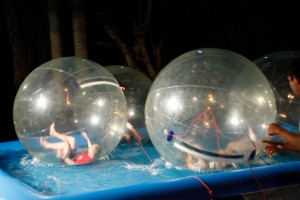 Towards the end of the evening a number of students had a good time going into floating spheres. Click on Spheres to see more photos. On Saturday we went to Poas Volcano. This is in a national park. It was cool and misty when we arrived and too cloudy to see the crater. After a taking an excursion on a side trail, however, we returned and we could see the bottom of the caldera and it was impressive. The forests we have seen (Santa Rosa, Volcán Rincón de la Vieja, Rio Grande Watershed, and Poas) serve to remind students that forest ecosystems of the tropics are not all lowland rainforests. There are clear reasons why they are different and in Panama we will start to articulate in more detail the factors that influence ecosystem structure and species diversity. Click on Poas to see photos of our visit to the Volcano.
Towards the end of the evening a number of students had a good time going into floating spheres. Click on Spheres to see more photos. On Saturday we went to Poas Volcano. This is in a national park. It was cool and misty when we arrived and too cloudy to see the crater. After a taking an excursion on a side trail, however, we returned and we could see the bottom of the caldera and it was impressive. The forests we have seen (Santa Rosa, Volcán Rincón de la Vieja, Rio Grande Watershed, and Poas) serve to remind students that forest ecosystems of the tropics are not all lowland rainforests. There are clear reasons why they are different and in Panama we will start to articulate in more detail the factors that influence ecosystem structure and species diversity. Click on Poas to see photos of our visit to the Volcano.
We arrived back in Atenas, and students had the rest of the day free. We have Spanish classes this morning, and we will try to wrap up the data gathering phase social science initiatives on recycling this afternoon. We plan to go the large mall “MultiPlaza” this evening to take a little break, and students can pick up sundries they need them.
Free Day – San Jose, Carara Ntl. Park, and homestay families
Yesterday lunch through the afternoon was very relaxed and pleasant. As Juan said “we arrived promptly on US time, but left on Tico time.” I didn’t mention dancing lessons yesterday, adding to the frisbee, soccer, cooking, eating, pinata, relaxing, and birdwatching.
Today we went in various directions. I ended up going with Juan and seven students went to San José. We walked around the city a bit, made some purchases at the artisans market, and had a snack before heading on back to Atenas. Amber went with Will and Amelia to a full day of birding at Carara National Park, a little more than an hour away. Some students went to public swimming pools or soccer matches with their host families. Tonight we are all going to the “Fiestas de Sabana Larga.” Sabana Larga is outer neighborhood of Atenas and the hold an annual festival that includes a “Tope” (or parade which includes horses). There is bull riding and other rodeo events, dancing, food, and small amusement rides. Juan, Amber and I will be there to help them navigate this event. Students are settling into the rhythm of the town, and they all seem to be enjoying themselves.
Tomorrow we are off at 8:00 am to see Volcán Poas. Poas is a mildly active volcano, and, if it is clear, we will see a small hot lake at the bottom of the crater. The visit will shift us over a little into the science and natural history mode. The forest and ecosystem there will most resemble our last site of the course–Los Quetzales. The area is moist and frequently covered with clouds, and the forest is dwarfed somewhat from the altitude and higher winds. We have switched things around a bit in the itinerary as this was the only day we could arrange transport to the volcano. We should be back early in the afternoon.
February 18 quick update
I am at an internet cafe and I don’t have a way to upload any photos. Yesterday after Spanish classes in the morning, we regathered at 3 pm to further develop the mini-social sciene project we began earlier in the week. We broke up into 4 groups and each discussed what we had learned and what we could or should do next to learn more. We came back together and had a larger discussion and move into thetopic of study design and methodology. Some things that came up were sample size, who is asking?, discrete categories vs more open ended questions, thesis, leading questions, etc. The students are developing some follow-up small scale studies.
In the evening we play soccer at “Futball Cinco.” Basically, this is indoor small field soccer in an open air but covered area. The majority of students played, and were joined by some homestay brothers and sisters. The atmosphere was light and we all had fun. I will be posted photos of this in the near future.
Today the 4 language classes, with their teachers, went to “La Feria de Agricoltura,” which is basically a farmers market. After buying fruits and vegetables, we took a public bus to a location about 3 miles out of town. This was thoroughly pleasant small country ranch. There was a small stream, big trees, wide expanses of grass and a covered cooking area. (Photos will be posted another time.) We cut fruits and vegetables, played frisbee and soccer, hung out, and some learned a little Costa Rican cooking. We also took some time from relaxing to continue to discuss the social science project regarding recycling in Atenas. We also made plans for tomorrow. Our altered schedule, calls for a free day tomorrow. Students can spend time as they wish, are encouraged to spend time with thier families or go with 3 faculty sponsored activities go San Jose with Juan, to Carrara National Park with Amber, or go to Zoo Aves” Steve. The Cafe is closing. I have to go. Please excuse typos. Oh…. the group celebrated my birthday today pictures more to follow. Thnak you. I enjoyed spending time with teenagers and watching them whack the Pinata. (Some photos will follow)
“En armonía con su salud y la Naturaleza”
Click for photos of San Isidro coffee farm: San Isidro coffee farm
See a video of our visit
“En armonía con su salud y la Naturaleza”
Yesterday we had a special treat. As part of our focus on land use and agriculture, we visited an organic coffee farm about 15 minutes by bus from the center of Atenas. The title above is the motto printed on the coffee bean bags “In harmony with your health and with nature.” The Spanish school director, spoke with several host families last night who shared with her how the students returned afterwards with opened eyes and full of stories from the tour.
This organic coffee farm is cared for by an association of eight families. I say “cared for” versus run or managed or owned because the approach the families use is one of tending to their own health and well-being along with the land.
About 16 years ago, this group of families made a conscious choice to separate from being part of a larger conventional coffee plantation and distinguish their coffee farm by using organic practices. While the yield of coffee is about 50% less, compared to conventional intensive practices, they balance this with being able to charge a bit more for the beans and receive the benefit of supporting their own communities’ health and long-term viability of their land.
Gabriel, our guide and an eloquent, humble and vibrantly enthusiastic farmer welcomed us to learn about how they have incorporated more and more permaculture practices through the years– designing their farm and home by modeling the relationships found in natural ecologies. Gabriel’s father one of the key people who started the farm, shared how he has noticed feeling significantly better after being quite ill when he was working on the conventional farm.
The majority of coffee growers become caught in a cycle of high inputs, adding synthetic fertilizer, herbicides and pesticides and a lot of water. Gabriel explained the perpetuating cycle something like this:
The desire make a fast profit, pushes farmers to have crops produce as much as possible. So a sun tolerant coffee plant is developed and farmers add fertilizer to increase the yield. This then encourages more growth of other weedy plants, which are seen as robbing water and nutrients from the coffee bushes. So herbicides are applied. Now, the insects, which were munching on some of the other nearby plants, must concentrate on the coffee plants, so pesticides are added. The ground around the plants is now barren. So when the tropical rains come, the water washes down the dry hillsides leaching out more nutrients and carrying with it these additives as well as soil into the rivers. So the farmers may need to add more irrigation and more fertilizer. And on top of this the exposure to the chemicals affects the daily health of people who work on the farms and rely on the water for living. Phew!
Gabriel shared how the key to permaculture farming is in the details. On the farm everything has a place and purpose. Over 100 different trees species, many of which produce edible crops like platano, banana, papaya, guayaba, poro, and vanilla help create a dappled shade over the coffee bushes. These crops are used to feed the families and the families work to manage the canopy to make sure just the right amount of light comes through for optimal coffee harvest. Gabriel and the other farmers worked with the topography of the land by digging little holding areas for the water with rocks and a type of plant called caño to allow the water to seep into the ground instead of running off the steep slopes. Leaves are allowed to fall from the plants and decompose naturally on the ground – this leaf cover creates a kind of mulch that maintains the moisture and keeps down the growth of too many weeds, although some smaller green plants are allowed to grow and their roots help maintain the soil. Dehydrated chicken waste fertilizer from a nearby farm is added at the base of the coffee bushes to bring in extra nutrients. All the coffee bean shells removed during processing are composted and then added back to the land. These are just some of the details we saw.
The way the coffee is processed is also unique. The family association purchased special machinery developed in Colombia which removes the coating and sticky pulp of the fresh coffee fruits using a less than 1% of the water used in a conventional processor. Check out the video to see it in action!
I am inspired by the depth of purpose that Gabriel, his father and the other families bring to their livelihood. The farm meets the highest international organic standards and beyond. Being an organic farmer in Costa Rica these days is not easy. The farmers must take on the financial risk and extra work of converting the farm to meet the organic standards and pay for the certification — the Costa Rican government does not support this financially. Despite the image of Costa Rica as supporting good environmental practices, in the last several years the numbers of organic farms has declined. The higher price that organic coffee gets on the market is not enough of an incentive. It takes farmers who see themselves participating in a bigger ecological picture and commitment to overall well-being. And as Gabriel encouraged, it takes consumers who care and actively choose to support people and food streams that encourage biodiversity and health along the whole web of interconnections.
We thoroughly enjoyed our visit and left with the delightful taste of freshly brewed coffee and cookies, several bags of organic beans to bring home and a new perspective. Thank you, Juan, for organizing such a great opportunity!
Spanish & dance classes & local forest visit
Click her for photos of dance class and Rio Grande watershed: Dance/Watershed
Click for a short (2 min) dance clip: Dance class 2-15
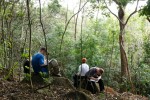 Internet has been unavailable in the evenings, so we are largely confined to morning posts. Yesterday morning Spanish classes started at 8:00 am. At 11:oo there were dance classes and just plain dancing. After returning to their homestays for lunch, we regathered at the Park for a 10 minute ride outside of town to an area of mature forest along side a small river–the Rio Grande. Atenas has a significant dry season, but it is not as pronounced as Santa Rosa. As a higher altitude site, it is also cooler. After some significant discussion of the concept of watersheds, we set out on a trail, doing field natural history as we walked along. We then broke into smaller groups, and students we are asked to make journal entries containing their observations, impressions and questions. In each group we also did some site comparison between this sit and Santa Rosa.
Internet has been unavailable in the evenings, so we are largely confined to morning posts. Yesterday morning Spanish classes started at 8:00 am. At 11:oo there were dance classes and just plain dancing. After returning to their homestays for lunch, we regathered at the Park for a 10 minute ride outside of town to an area of mature forest along side a small river–the Rio Grande. Atenas has a significant dry season, but it is not as pronounced as Santa Rosa. As a higher altitude site, it is also cooler. After some significant discussion of the concept of watersheds, we set out on a trail, doing field natural history as we walked along. We then broke into smaller groups, and students we are asked to make journal entries containing their observations, impressions and questions. In each group we also did some site comparison between this sit and Santa Rosa.
We gathered back together as a large group and brought together ideas from each group into a larger discussion. Beyond site comparison, we also touched began a discussion of pollination ecology and seed dispersal. As this site was a small fragment of forest as compared we also talked about park design with respect to size, range of habitats within the park, and target species for protection. We’ll build on these topics as the course progresses.
Some of the things we experinced included tasting a forest fruit–guapinol (not a big hit among all(see some photos) ), a Buteo sp. hawk, a fox, a huge leaf cutter ant colony, balsa wood with “fairy disk” seeds, and termite nests.
We returned at about 4:30. Most students remained in the park for a while before returning to their homestay families for the evening. While there is some anticipated period of adjustment, the homestays are working out well. Some students report some problems sleeping because of the noise of barking dogs, roosters etc., but that seems to be getting better as well.
(Note: See posted photos of Jeff and his host sister with their birthday cake. )
Day 2 in Atenas
Click to see photos of day 2 in Atenas
We arrived at Isabel’s Language School at 8:00 am. The group was divided into 4 classes. After some orientation in the school, students took a tour of the town and learned some of the most important places such as the central park, the large church on the plaza, the bank, central park. They returned and began their classes in earnest. At noon classes ended and students returned to their homestays for lunch. We regrouped in the central paza at 2:30 pm. We had a group checkin as to how things were going. We then broke into 4 groups that were assigned four tasks to do in all Spanish in one hour. They are summarized below:
1) Find the cheapest, as well as the best, internet Café.
2.) Find out where to buy phone cards that would serve in making international cards.
3.) Find and buy an exotic fruit unfamiliar to them and learn something from vendor about it.
4.) Each group was given a glass or plastic bottle. We requested that they ask 6 people (3 males, 3 females, 2 young, 2 middle aged, 2 older) about where they could recycle the bottle. They were instructed to ask followup questions.
We then got back together to discuss the results. We had interesting findings and questions about recycling, and we plan to follow up and develop a more sophisticated survey in the near future.
At about 5:30 we ended the activity and students returned to their homestays. Today we have dance classes at 11:00 am, and in the afternoon we will be visiting the Rio Grande watershed near Atenas.
Internet has been a bit a spotty for me. We’re busy during the day, I don’t have internet in my homestay, and the internet cafés in town close at 6:00 pm. We will do our best to keep you updated. We are working (I think succesfully) to make calling home easier and cheaper. More on this later. I have to go. We hope to post later today.Please excuse typos/grammar as many posts are done quickly with little editing.
Homestay Entry
Here are some photos of students meeting their homestay parents and entering into their homestays (Homestay Day1). We’re in classes now everyone is fine.
Arrival in Atenas and Reflections on Santa Rosa
We’ve arrived in Atenas! Each student spent the first evening with his or her host family. It feels a little strange to be spread out now after 4 days dormitory bunk style living!
Meeting up with the families at the drop-off locations went smoothly thanks to the hard work of Juan and the Spanish School director, Isabel, who have been working tirelessly to match students with their homestays and prepare for classes. We waved goodbye to each student last night and this morning reunited for the first day of Spanish classes. The students arrived smiling broadly and brimming with stories.
We enjoyed our time in Santa Rosa. Fifteen years ago, when I was a student on the Tropical Ecology and Spanish course, we stayed in the same research station dorms. The nearby landscape has transformed considerably since then. I remember being able to look from the bunk rooms across the dry, mostly open area to the cafeteria. Now the view is blocked by the thick tangle of trees, shrubs and vines. Little winding pathways connect the buildings. This different view is part of the effect of a grand reforestation project to bring back the dry forests to Santa Rosa.
About 400 years ago, the pacific dry forest, which was once quite expansive and stretched down from Mexico, was almost completely converted into pastureland for cattle. The ranchers introduced a hearty grass from Africa that took well to the extreme conditions, producing a savanna-like landscape with the arching Guanacaste tree, one of the few trees left standing. However, about forty years ago, at the dawning of the conservation movement in Costa Rica, a track of land in Santa Rosa became the very first national park in the country. Over the years, the government continued to buy more land creating a unique corridor of protected land. This “Area de Conservacion Guanacaste” now encompasses four distinct bioregions and stretches from out in the Pacific ocean marine area, across the regenerating flat dry forest, up the over the volcanic ridges and cloud forest and down to the mountain slopes of the Caribbean side. I find it quite exciting to be able to personally see the changes in the landscape from this dedication to conservation and reforestation.
The rainstorm that passed through while we were in Santa Rosa points to greater global patterns of environmental change. We are officially in the dry season here. So the rainfall comes as a surprise. A researcher from the national park who spoke with the group also mentioned new trends of multiple days without clouds in the cloud forest. These are telling events to the biologists who have studied this landscape, and to them quite worrisome, since it disrupts some key life cycles of plants and animals. Too much rain too soon may cause some animals like frogs, which we saw out on the trails, to lay eggs to soon, or for seeds to sprout before there is enough moisture to support their full growth. What will it be like in another fifteen years? What new plants and animal communities will begin to flourish again and which ones will need to shift to other areas, as the new growth of trees shade the grassland. The land here is a portrait of the changing trends of human values.
And to close, let’s thank the inventors of paired back wheels on a bus! While we had a bit of a scare when one of the tires blew, all worked out fine and we made it on time. The bus driver José, navigated us from one tire repair shop which was closed because it was a Sunday to another only a few kilometers further up the road. Luckily the shop owners here lived out in back and a young mechanic in flip-flops hammered and hoisted with an almost effortless quality until we had a replacement wheel.
Our last afternoon & evening in Santa Rosa
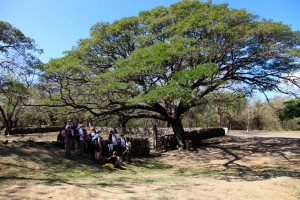 Feb 12 (Click for photos)
Feb 12 (Click for photos)
At about about 5:00 pm we went loaded up our picnic supper and traveled to the top of a steep hill adjacent to “La Casona.” There is a monument at the top of this strategically important hill that commemorates those who died in the Battle of Santa Rosa. We ate supper as the sun set and the view and ambience were spectacular. Juan remarked that it was like sitting on top one of the temples in Tikal in Guatemala that overlooks the expanding jungle, and I agreed. (We had been there with a 2005 CSW course.) After the sun had set, we returned to La Casona, before setting back to the field station for a long night hike, meandering through roads and back trails. We saw nightjars, many insects, scorpions, and frogs. The prize of the night was a beautiful boa. They are not dangerous but need to be treated with respect. We returned at about 8:00 and the students set in packing and just enjoying the last night at the station.
When we returned the internet had gone down! We were unable to email or post. In Atenas communication by phone and internet will be both better and more predictable. The students are doing well. Some had to rest a little after our long day at Volcán Rincón de la Vieja, but all were positive about the coming day. This day was not so physically demanding, and the students were very productive. Almost everyone is a little nervous about heading into their homestay, and that is normal. Realize that we are on central time so the posts may be a little late for some of you. We’re looking forward to the next stage. More to come soon.
Rain in the Dry Season
In the dry season any rain is welcome. It refreshes the whole ecosystem. Many of the plant and animals living in this area have to endure the tight bottleneck of very little rain for several months. Rain is plentiful the rest of the year. Today, it drizzled very lightly during the morning field exercises making the whole morning very comfortable to work in. After lunch and a lecture, at about 3:00, it started to rain steadily given the vegetation a real soaking. This kept the afternoon cool (in low 80’s). While the rain gives a welcome respite from the heat, we hope it doesn’t cut into our planned sunset picnic supper.
As for the day for our group… we had breakfast at 7:15 and students moved through 3 stations in hands on learning of some field equipment. Some of the equipment Students learned to use include sling pyschrometers (dew point and humidity), clinometers (for slopes and heights), and densiometers (canopy cover). They also explored different protocols for gathering samples of populations. After a brief break, we broke into 3 groups that all looked at the tight mutualistic co-evolutionary relationship between Bullhorn Acacias and Pseudomyrnex ants. See Will’s capstone blog for more details. In this exercise we moved from observations and questions to the process and design of small experiments to try to answer a question or test a hypothesis. I was very pleased with the relaxed good energy, good insight, and effort.
We then had lunch and a brief break before having a lecture from one of the leaders of ACG (Area de Conservacion de Guanacaste). This is a large connected series of parks that connect large tracts of marine, dry forest, cloud forest and rainforest ecosystems. The protected area of dry forest is the largest in the New World. The lecture was in Spanish. The lecturer spoke slowly and clearly and he had good a current visuals. He moved to English only to reinforce more complicated points. He clearly outlined the growth of the park since its inception in 1966. The first piece had been a huge cattle ranch, and the site preserved initially because it’s historical importance as the site of a the battle of Santa Rosa.
I have to run off now. I know you really want to hear about your kids and see some visuals. I will have time tonight to post
Update from Volcán Rincón de la Vieja
Hello this will be necessity a short entry. We had a full day in our excursion to Volcán Rincón de la Vieja, and we didn’t return until 5:45 for an immediate supper. The generator at the station failed immediately at the end of a post supper orientation on the upcoming homestays in Atenas.
Briefly about the excursion today: The site offered a greener, more foliated forest, cooler and windier conditions, many strangler figs, a wild boar sighting (and smelling), toucanets, a climb up the middle of a strangler fig, fumaroles, boiling mudpots and more. The reason why the course offers athletic credit became obvious to all. While we came home tired, everyone stood up well. We’ve modified the schedule slightly tomorrow, to ease up a little before our trip to Atenas the next day. Nevertheless we will have some field exercises in the morning, and a lecture/discussion from a major researcher here in the late afternoon we will have a picnic supper at place in the with a spectacular sunset. This will be followed immediately by a much anticipated night hike lead by Johann, a Park employee whom the students enjoyed for our orientation walk on Thursday morning. This will supplant the initially planned trip to Playa (beach) Naranjo, but the logistics and current road conditions make this unfeasible.
There is plenty to say and show you, but it’s past time to turn out the lights and go to bed. More will follow tomorrow.
Steve
Student Voices Tab & Page added
This site is evolving with, and I’ve added a new page & tab which will “post” student contributions, which may be taken from a separate blog they have created. We support the students in having a separate blog with more latitude, but they have come up with some great stuff and we want to be able to share some of it on this site. See below and entry by Jeff covering yesterday.
Second Night in Costa Rica! (posted 2-10-11, by Jeff Dinardo)
So it looks like another peaceful night after an amazing day at the Santa Rosa Dry Forest. Today we saw tons of animals, with deer everywhere and a band of white-face monkies coming right outside of the cafeteria. The food, maybe not so suprisingly, is delicious. Here, it seems rice and beans with some other option is the staple, as well as variations of ham. Tomorrow we go to a volcano to hike and observe the vegetation, which has been nothing short of incredible. Already, I have learned tons, mostly without trying, as there are so many types of plants and animals that I didn’t even know existed. So hopefully tomorrow will not be too hot for our hike, and it turns out to be a good one.
Student Photos Santa Rosa I
Here are some student bird and animal photos from today (Student Photos Santa Rosa I). Amelia, Niko, and Jesse contributed. We will post photos of the group tomorrow, but it won’t be until the evening as we have a full day away from station. Photos posted on the site may be rearranged at some future date.
CSW YouTube channel created by Jesse Phillips
Jesse Phillips has created a YouTube channel for the course, and he has posted a 30 second video of white-faced monkeys we saw around the field station. See it at http://www.youtube.com/user/cswoffcampus
The rest of the day…
To to get an excellent summation of the day, check out Will Freedberg’s blog at http://wfreedberg.tumblr.com/ Will’s blog is part of his Capstone. You can go to his site directly or link to it from this site.
After supper, we gathered to sort through “leaves and seeds,” and to discuss the afternoon’s field exercise. We also prepared for our excursion tomorrow to Volcán Rincon de la Vieja. We will go up significantly in altitude and we’ll see a gradual change to cooler and more moist conditions. By comparing this higher altitude forest to the very dry forest in Santa Rosa National Park, students should get a better sense of factors that shape forest structure and ecology.
It’s siesta time at Santa Rosa
We got in last night at about 8:30 pm local time. It didn’t take long to get settled into the dorms at the Research Center/Park Headquarters. We got up for a 7:30 breakfast, and then went out for an orientation walk with one of the park rangers. More detail will follow later today (including photos), but we got a good introduction to the tropical dry forest, and we saw a lot of great stuff including deer, agoutis, white-faced monkeys, spider monkeys, ctenosaurs and many birds. While the night was fairly cool for sleeping and the morning walk fine, it is very hot now (in the 90’s) and we’re taking some down time before venturing out again at about 3:30 pm to see a slightly different type of (and primary) forest. We will do some field exercises there before returning for dinner at 5:30. It’s a full schedule, but we are staying cognizant of student needs and energy levels–both general and individual. We will adjust as necessary to suit their needs. We see excited, connected kids, and we’re pleased with how the group is shaping up.
Course Itinerary
We have posted a day-t0-day course itinerary. You can access it by hitting the “Course Itinerary” tab above or the right. While there will be some modifications as we go along, it should give you a good idea of what we are doing on a day-to-day basis.
Travel information for February 9
Travel information first few days
Please arrive at the Airport (terminal B) at 6:00 a.m.
(Note that that this information is also contained in “Travel Dates and Destinations.”)
Dates and Destinations 2/9/11 Wednesday Fly from Boston to San Jose: Lv Boston, Logan Airport 8:00am US Airways #821 — Ar Charlotte 10:26am Lv Charlotte 11:22am, US Airways #1707 — Arrive San Jose, CR at 2:35pm Bus pick-up drive to Atenas, transfer to bus to Santa Rosa Parque Nacional Santa Rosa 2/9/11-2/13/11 (4 nights) Contact: Maria Luisa Arias Email: mlarias@acguanacaste.ac.cr
to San Jose: Lv Boston, Logan Airport 8:00am US Airways #821 — Ar Charlotte 10:26am Lv Charlotte 11:22am, US Airways #1707 — Arrive San Jose, CR at 2:35pm Bus pick-up drive to Atenas, transfer to bus to Santa Rosa Parque Nacional Santa Rosa 2/9/11-2/13/11 (4 nights) Contact: Maria Luisa Arias Email: mlarias@acguanacaste.ac.cr
Carra Cheslin CSW ’07 is joining the group as a teaching intern
We’re pleased to announce that Carra Cheslin CSW ’07 will be joining our group as a teaching intern for the Panama portion of the Course. Carra was a student on the 2007 CSW integrated Science and Language course in Costa Rica and Panama. She is now a senior at Connecticut College and immersed in environmental studies. She studied last year in Brazil, went up the Amazon, and spent time in the rain forest. This past summer she interned in San Francisco at the Rainforest Action Network. This past fall she attended the UN Climate Change negotiations in Cancun as a member of the SustainUS youth delegation. See the following link for more information about her http://aspen.conncoll.edu/news/6634.cfm.
She will add a fresh perspective and training, more support for project work, as well as more gender and age balance in leadership. She will also be able to provide students with a first hand perspective on opportunities in college and outside of CSW. Carra will be the third alum of the course that has returned as a teaching intern. We feel that having well trained and invested alums join teachers, students, and local experts provides a rich and important element to the dynamic of the group. Carra will fly to Costa Rica on the 23rd of February, join us on our overland bus journey from Atenas, Costa Rica to Panama on the 24th. She will return with the group on the March 9.
Parent Informational Meeting Tuesday January 11, 7:15 pm
There will be an informational meeting geared to parents on Tuesday, January 11 at 7:15. The meeting will be be held in Bio 1 in the Garthwaite Bldg. Bio 1 is the first classroom of the right as you walk in the main entrance of the Garthwaite. Admissions is holding an event at the same time. You don’t need to sign in when you enter the building. Just go directly to the classroom.
In Miami!
On US soil, waiting for flight from Miami to Boston. All is well.
Anne
We’re in the Tocumen Airport in Panama City
Our morning has gone smoothly. We loaded our bus at the Los Quetzales hotel at about 5:00 am and then got underway about 5:20. We arrived at the airport in David in plenty of time. Our flight from David to Panama City (Albrook Airport) was smooth. We got picked by a bus at Albrook that then took us to the international airpot (Tocumen). We’ve now cleared immigration, and we’re now waiting at the gate to board the plane.I don’t know if we will get chance or not to update you in Miami. We will try to write a brief entry if we can get internet access. We don’t anticipate any problems and we look forward to seeing you all soon.
Here’s the rest of Will’s blog from yesterday- the computer was low on power then, but it’s the continued from same entry from previous post-
“In addition to our projects, we had plenty of scheduled hikes and activities. Our guides, Abel and Jose, were quite a team– Jose was quiet and serious, but knew the forest like the back of his hand. Abel was animated and questionably sane, but was a fantastic naturalist and wonderful guy. (He also knew the best bird imitations of any guide I’ve ever worked with). We explored the mystical, fairytale-like forest in small groups, marveling at kinkajous and quetzals. Everyone enjoyed the peace and quiet, and notable lack of bass-boosted reggaeton blaring from windows.
There were no major hang-ups, either– the food was excellent (even the breakfasts we made ourselves!) and nobody got sick. The group dynamic was perfectly fine, and I certainly bonded with my cabin-mates. By the final night, we were hardly ready to head down to the main hotel, but had a fun day of hikes, horseback rides, and visits to a local orchid farm.
The group is now in Tocumen, where we’re sitting through a long layover. It won’t be much more fun in Miami Int’l, but we’re enjoying each other’s company and ipods. We’ll be arriving back in the states around midnight, ready to recap with you all and start posting photos (for real this time….)
Best,
Will Freedberg
Late Wednesday post from Los Quetzales
We’ve had our 12th consecutive full day of activities. We just finished with some student presentations of individual projects involving combining drawing and photographing birds and comparing night and day reef life. The cloud forest was spectacular and now we’re busy getting prepared for an early morning departure. We will have some final entries when we are a little less busy. All is well. I have uploaded some photos. Only some are from the last 2 days; most are from the whole trip. Click on “Photo Gallery” on the right hand column to see new entries from Amber, Gina, Sayre, Travis, and Steve.
We will be posting more photos, but probably not until after we get back. I will try to let you know when we clear customs in Miami. We left ourselves even more time in Miami than the airlines recommended as that has been a bottleneck for us in the past. We’ll see you soon.
See Will’s post below:
“This evening was a fitting end to a wonderful trip. We went out to dinner at a restaurant in Guadalupe town proper, and had a final group check-in to wrap up the trip. It really did feel like a matter of days ago we had our first, and in fact, it wasn’t that long ago. We discussed trip highlights and toasted the group leaders, and then went on to dinner- which included the most fantastic strawberries and cream dessert imaginable. After dinner, the group went to watch two of our members join in a game of pickup soccer with local teens, which was an nice means of cultural exchange. And we got some much-desired free time at the hotel to wrap up the trip, where we discussed our impressions of the country with friends over games of ping-pong and chess.
I’m still a little stunned at how many experiences we managed to pack into ten short days. My eyes are glazed over, I’m slumped over the computer- exhausted, but a fulfilled, content kind of exhaustion. Los Quetzales was, cliché as this sounds, the most beautiful place I’ve been in my life. And this is coming from a nature freak who’s managed to haul himself to nine countries and twenty states over the past few years. Our chalet-style cabins were situated in totally pristine, always-misty montane cloud forest. They made fore the perfect spot to reflect on our work at ITEC, compare the forest with that on Isla Colon, and continue some independent studies at higher altitudes. Students’ projects at LQ included learning Spanish naturalist jargon from local guides, mapping local rivers, studying Resplendent Quetzals, landscape drawing, and frog ecology- quite a spread! We had plenty of time to bond with our cabin-mates and hang out. Still, even when we weren’t being asked to work on our projects, many folks were drawn to them anyway.
There’s a whole lot more to say here. Unfortunately, Steve’s Mac is running out of reserve battery power (too many photo uploads, etc). I’ll fill everybody in on the rest of the trip tomorrow, but it wont be too long before the group is back in Boston.
But honestly, I wouldn’t mind staying here another mod or so.
Best,
William Freedberg”
Last post from Panama!
Tom reported that while in the cloud forest students were engaged in a variety of individual activities including meditating, photographing birds and bats, reorganizing the packing list, etc. The group left the cloud forest mountain this morning and did a hike and horseback riding today. Tonight they are spending their last night at a hotel at the base of the mountain. Everyone is happy and healthy. Tomorrow morning they will be up early for the journey home!
Anne
Message from Tom 3-22-10
I spoke to Tom on Sunday evening and am just now getting around to posting. The group arrived in Guadalupe on Sunday. They are staying in teak cabins 7,000 feet up a mountain, literally touching the clouds. They had a delicious dinner cooked by a “grandmother.” The scenery sounds quite spectacular with views of jungle, mountains, farmland, clouds, and at night, stars.
Anne
Message from Tom Evans
Tom called in a message before the group left for Guadalupe today. Everyone has started their art projects such as landscape painting, photographing birds and plants, drawing plants, etc. Cold water showers. An occasional upset stomach but no serious illness. All is going well.
Anne
Some Photos From ITEC
Click on ITEC or go to albums on right hand side to see some photos. We have many. many more. We aren’t at the facilities where we can post easily.
Hello from Cerro Punta
We got on two boats in Boca del Drago for about an hour ride to Almirante n the mainland. In our bus ride from the Atlantic port of Almirante we went up the continental divide (about 3,000 feet at the roads highest point) and then down to the Pacific coastal city of David. The whole Atlantic to Pacific trip took us less than three hours! When then went back into the mountains into the region of Cerro Punta. On our journey today we went form hot humid, to cool, to hot and dry to cooler moist. We are saying goodbye to mosquitoes, and the heat, as well as to the ocean, coral reefs and the rainforest. We are excited about our next phase of the course. The cloud forest is an incredible place, while it may cool and wet, it is incredibly green and the forest has a unique character. It provides a good contrast to the lowland rainforest. Comparing the two locales can be helpful in understanding the forces that structure tropical ecosystems. For our first 3 nights in Cerro Punta we will stay in cabins owned by Los Quetzales Hotel. The cabins are quite far form the hotel itself. It takes about 25 minutes by 4 wheel drive vehicle over some very rough road to get to them. For the last night we will stay in the hotel itself. It will allow for a much quicker getaway on the morning of the 25th. The next time that I know that we can make a blog entry is on the 24th. While cell phone coverage is spotty in the areas of the cabins you most likely will be able to reach us if you need to.
Call 6936 4073 and Steve will answer
Call 6929 3353 and Amber will answer
Call 6936 4073 fro Steve
See Will’s blog entry below:
“From the bus to Los Quetzales in Cerro Punta:
We’re all on a comfortable and typically “speedy” Panamanian private bus heading up to the highlands. An early wake-up call got everybody on a boat to the small banana port of Almirante (with a quick stop at a restaurant for some superb fried dough). From there, we started off to Los Quetzales. The group is in good spirits, and I think everybody is happy with their group research projects from ITEC. Our papers will be posted when we’re back if not sooner, but here’s a teaser:
-Comparative biodiversity on the fore-reef and rear-reefs of Bocas del Toro
-The distribution and ecological role of Mangrove Oysters in brackish creeks
-Examining tank communities in Heliconias, including copepod distribution and flower cycle
-Studying Dendrobates poison-dart Frog territory sizes and breeding habits with mark-recapture methods
So, you can tell we’ve been working on a nice variety of studies. Not all of them had significant conclusions, but are part of important ongoing research at ITEC. It wasn’t all hard work though, and we also had plenty of time to strike out in smaller groups to explore or relax. I especially enjoyed some volleyball matches on the beach, smoothies in the nearby “town”, and getting to know our cooks for the week, Sylvia and Jeanetta. The wildlife was also wonderful, and we would regularly cluster up on a trail to quietly observe anything from howler monkeys and sloths to toucans and treefrogs. In addition to the group projects students engaged in individual art and/or science, for example:
-Using natural rainforest pigments and clay to make pre-Columbian-style art (Tom even improvised a kiln!)
-Wildlife-related art, photography, and research
-Heliconia dissection
-Mapping reef ecology webs
-Starfish movements
-Studying the station gecko populations (most of the marked geckos were recaptured from our rooms, but everybody still slept well- healthy gecko populations means fewer mosquitoes)
The individual initiatives will continue during our stay at Los Quetzales, but the group research projects will be replaced by a series of scheduled activities, nature hikes, and the like. We will not have electricity for a little while after this is posted in the main hotel, so it may be a while before we update our folks back home on how things go in the highlands- but everything from accommodations to research opportunities looks promising. Now, we’re moving slowly up the altitudinal gradient towards the cloud forest, dated American disco hits blaring from the radio, and enjoying the cooler breeze from the bus windows. It certainly is wonderful for me to get back in the neotropics, and the rest of the group is equally (if not more) happy to be here.
Till next blog,
William Freedberg”
Message from March 18
Tom left a voice mail message yesterday, March 18, that I didn’t get until tonight:
“Everyone is healthy, happy and getting along well. Four group projects have started: Oysters in the Mangroves, Poison Dart Frogs in the Forest, Biodiversity in the Water, and Microscopic Life Inside Flowers. All the students are also working on individual projects as well, for example, Ancient Ceramics, Leaf Cutter Ants, Starfish, Hummingbirds, Gekkos, etc.
Steve’s cell phone (6929 3352) has been lost. Instead you can call 6929 3353 or 6936 4073 if you need to reach the group.”
Anne Priestley (Scribe for Tom Evans)
Update from “Boca del Drago”
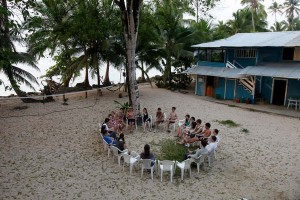 We’re well settled into a routine the ITEC field station that keeps all busy as well as enjoying ourselves. The ITEC field station is located in Boca del Drago (“Mouth of the Dragon”) on Isla Colón. There is no Internet connectivity in the end of the island where ITEC is located, and this is the first chance we’ve had to update you directly. Thank you Anne for keeping the group updated in the interim. Below find a blog entry from Will Freedberg that captures our experience well. I also include some photos. Click on “Photo Albums” or the photo to to see a photo album. The next time we can definitely update is Sunday late afternoon or early evening. Other than one encounter with sea urchin spines and some mosquitoes bites and some sunburn (we are taking sun protection measures) are well, productive and happy. The following is Will’s blog entry.
We’re well settled into a routine the ITEC field station that keeps all busy as well as enjoying ourselves. The ITEC field station is located in Boca del Drago (“Mouth of the Dragon”) on Isla Colón. There is no Internet connectivity in the end of the island where ITEC is located, and this is the first chance we’ve had to update you directly. Thank you Anne for keeping the group updated in the interim. Below find a blog entry from Will Freedberg that captures our experience well. I also include some photos. Click on “Photo Albums” or the photo to to see a photo album. The next time we can definitely update is Sunday late afternoon or early evening. Other than one encounter with sea urchin spines and some mosquitoes bites and some sunburn (we are taking sun protection measures) are well, productive and happy. The following is Will’s blog entry.
“All is well with our group here on Isla Colon. Students have snorkeled three different sites and compared them, and worked on field journaling in the nearby secondary forest. We’ve already managed to turn up large groups of howler monkeys, a three-toed sloth, and a wonderfully diverse spread of tropical birds. Folks are generally surprised with the quality of food and accommodation here, (although there have been a few minor hitches, like the occasional frog chilling out in a bathroom stall).
The past couple of days were jam-packed but carefully planned. After arriving in Panama City with no delays or inconveniences, we went to see the famous Miraflores Locks on the Panama Canal, and the accompanying museum. The museum was informative but admittedly cheesy, although everybody marveled at the locks- true masterpieces of engineering. After seeing the Canal, our planned rainforest hike was precluded by a rainstorm, so we quickly regrouped and decided to hit the local mall for snacks and supplies. As a wildlife enthusiast I was pretty down about missing the lowland forest hike, but I don’t think anybody else minded. Our hotel for the evening was comfortable, with potable tap water.
We slept well and were up early for our trip to Bocas del Toro. Everybody settled in nicely yesterday, and we’re getting used to the rhythms of life at ITEC. Between excursions, classroom discussions, lectures, and meals, we’ve got plenty of downtime to explore the area- although most folks spend their free time exploring the same areas we’ll have just come back from! The ocean is calm, and the forest rich and steamy (and of course, intensely hot). It’s also nice to sit on the beach and reflect on what we’ve seen so far, and in my case distance myself from last mod’s stresses. We’re just now beginning to brainstorm and organize for our upcoming group projects, which should include studying frog populations, Heliconia ecology, and mapping transitions of Oyster populations between mangrove and reef ecosystems. In the next couple of days we’ll be focusing on these as well as individual initiatives, producing two polished studies and a field journal by the end of our stay- then, off to the cloud forest! The group is starting to gel and work better as a cohesive unit, and I’m looking forward to seeing how our dynamic develops.
We’ll try to post again soon, but internet is limited. I’m writing this for Steve to upload it at the airport as he picks up our missing faculty member, Tom, who got held up in Boston because of passport troubles. Until we get internet next—
-William Freedberg
Update: We didn’t get access to the Internet when we thought we could, so the last post is a little late. Since then, we’ve had two more very full days of early morning excursions, afternoon projects, and evening classroom work. Projects include reef transects, studies of microorganisms in Heliconia flowers, and mark-recapture methods with frogs. I have to run unexpectedly- projects call- but we’ll try to write again soon.
-Will Freedberg
Tom Evans has arrived in Panama
Tom arrived in Panama on Tuesday, March 16 around 4:30 pm, very tired after more than 12 hours of traveling but having experienced no travel snags this time.
FYI, the time in Panama is one hour earlier than in Boston.
Anne Priestley
Update Mon March 15 9:30 pm
Steve called in to report that everyone is safe and happy. They went snorkeling, took a 3 hour walk in the woods, and started their science projects today.
Steve’s cell phone number is already posted but here it is:
011 507 6929 3352
Tom was successful at getting a new passport today and will be on his way to joining the group in Panama in a few hours!
Anne Priestley
We’re in Gamboa
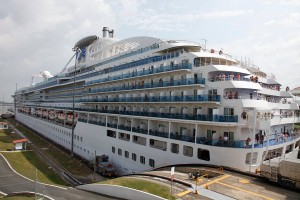 We’re in the Soberiana Station in Gamboa. We’re all a bit tired, and we’ll sleep well tonight. It is an exotic location adjacent the canal and large tracts of rainforest. We’re off early again tomorrow, so we’ll get only glimpse of the adjacent area. After we arrived in Panama our first major stop was at the Miraflores Locks. The have a museum and an observation tower there. We saw a large cruise ship and large container ship go through the locks. Seeing the canal, the old canal zone and Panama City will serve to give some context for the rest of the course.
We’re in the Soberiana Station in Gamboa. We’re all a bit tired, and we’ll sleep well tonight. It is an exotic location adjacent the canal and large tracts of rainforest. We’re off early again tomorrow, so we’ll get only glimpse of the adjacent area. After we arrived in Panama our first major stop was at the Miraflores Locks. The have a museum and an observation tower there. We saw a large cruise ship and large container ship go through the locks. Seeing the canal, the old canal zone and Panama City will serve to give some context for the rest of the course.
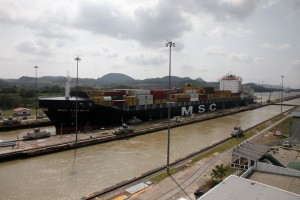 We have two cells phones at the moment that we can use to both call out and receive calls.
We have two cells phones at the moment that we can use to both call out and receive calls.
69293352 (in Steve’s Possession)
69293354 (in Amber’s Possession)
To call either from the U.S. dial 011-507-(8-digit number)
We will post when we can.
Steve
Hello from Panama City
Steve just called to say they had arrived safely and were enjoying dinner at a restaurant in Panama City.
On a related front, Tom Evans plans to go to the Passport Office in Boston tomorrow to negotiate an expedited new passport and hopes to join the group in Panama City on Tuesday if all goes well with the bureaucracy.
Anne Priestley
parent of Cooper Evans
We’re Safely in the Miami Airport
Hello All,
The flight left on time, and surprisingly it was a smooth flight. We got into Miami about 20 minutes early. Great job by all on getting there on time. Thanks to all who helped to get them there.
Unfortunately, Tom Evans encountered a curious rule of Panama, that you cannot enter the country if your passport expires within 3 months of your return. After 2 calls to Panama, we were told that although there might be someone on Monday that could authorize his entry, he would not be allowed in Panama if he got on the flight today. Plan B has Tom getting an expedited passport on Monday in Boston, and flying down to meet us on Tuesday. We hope and expect that this will all work out.
The gate for the next flight was near our arrival gate and all is going smoothly. We will be getting onto our next flight shortly. Many did nap on the first leg, so we’re beginning to recoup some of our lost sleep. We do expect to get cell phones today and sometime today we will post those on the web (probably not until evening).
We will be getting picked up at the airport by a bus, and expect we will be viewing the Miraflores locks of the Panama Canal sometime in the afternoon.
Steve
American Airlines links that may be useful
Checked Bag Policies and Fees visit:
http://pdp.link.aa.com/r/5OASNW/EYNJY/NPLM5J/WPA2N/IYVTXX/AZ/t
Carry-on Baggage Allowances visit:
http://pdp.link.aa.com/r/5OASNW/EYNJY/NPLM5J/WPA2N/WLEMPU/AZ/t
Flight Status Notification visit:
http://pdp.link.aa.com/r/5OASNW/EYNJY/NPLM5J/WPA2N/5CPEO0/AZ/t
Gates and Times Informations visit:
http://pdp.link.aa.com/r/5OASNW/EYNJY/NPLM5J/WPA2N/YH94LH/AZ/t
Checking in at American Airlines on Sunday
Check in at terminal B 2 hours before the flight. The following are some key points concerning Check in:
• Logan airport opens at 3:30 am.
• You should be at the terminal at 4:15 a.m.
• Sunday, March 14 is the day that we convert from EST to daylight savings time. So the check-in time will feel like 3:15 am.
• Our flight leaves from terminal B (listed as a domestic terminal when you enter the airport). Our gate, at this point, is listed as gate 34.
• The tickets are electronic. You don’t need a paper ticket at all. You DO need your passport. They will swipe the bar code on your passport and the ticket information will come up. I was told you will be able to check in at the ticket counter or you do yourself at a kiosk.
• Everyone should be very much under the baggage limit weight . You’re allow 2 checked bags (up to 5o lbs each) and one carry-on bag (up to 40 lbs). A small additional carry-on purse or small bag should be allowed as well. Please note that Air Panama has different weight requirements: 50 lbs total and officially 5 lbs for carry-on bags. You will be charged for weight over 50 lbs. You almost certainly will be allowed more than 5 lbs for carry-on baggage.
Tropical Studies in Panama blog is now active.
From this time forward through the upcoming course (March 14-March 25) we will actively maintain this blog. Comments are welcome. Posted comments and questions will be read and responded to if needed. Please see basic instructions by clicking on the ‘About Commenting” link on the right-hand column.
While internet connectivity is very limited at the sites we are going to in Panama, we will update this site with descriptions and photos when possible.
Boquete
Click on Bouquete to see more photos of our final full day in Panama
We left the beauty of the cloud forest in Los Quetzales in a timely manner. (The group has been amazing in terms of efficiently moving from place to place and from task to task.) We did see the Resplendent Quetzal (one of the holy grails in birding) in our morning exploration near the Parque La Amistad entrance. We then set off to Boquete, another town in the highlands of the Chiriqui province of Panama. The students had a free afternoon. In the evening we had a Pizza dinner followed by trip to the ice cream parlor. We’re all well. Our itinerary tomorrow has fairly long layover in San José and a relatively short one in Miami as we have to clear customs. We should be in Boston around midnight. The students have been wonderful in the course. Thank you for sending us such great kids!
Plans for last full day update
With the recent rains there are some tree falls and some small slides on the Los Quetzales trail, and we are advised to forgo the hike. Instead we will go to some areas near the beginning of the trail and spend some time in the forest there. We may be able to see the resplendent quetzal birds feeding at one of their favorite trees. We then will prcoceed to Boquete, have lunch along the way and arrive early to mid afternoon. In Boquete we will be staying at Los Fundadores. We will have our final dinner all together and debrief the course experience. Our travel plans for leaving Boquete and returning home remain the same.
Living in the Cloud Forest
Click on Living in the Cloud Forest for more photos. (About half of these phtos were taken by Matthew B.) Double click to enlarge any photos.
It’s Monday morning, and this is the first time the group has come down from the mountain. Most of the students are still visiting a local organic farm. The majority of the basic produce in Panama is grown in this region. It has very excellent volcanic soil and very predictable rainfall.
We are staying a little higher up than the town and it is a true cloud forest It is more often misting or raining than not, but we are happy and comfortable. We are staying in 3 fanciful wood cabins set right in the cloud forest. They are about 10 to 15 minutes some distance apart from each other, and each has its unique charm. Last night at the cabin at which I’m staying, we had visit from a Kinkajou and Cacomistle to feed off of bananas that we had left on the porch. We also watched nectar-feeding bats finish off the contents the hummingbird feeders. A mother/daughter team in the most central cabin prepares our lunches and dinners, and the food has been excellent. The forest itself is fantastic–very green, the trees are covered in epiphytes and dripping with moss, and the many streams are rushing with high water. While the weather overall in Panama has been unseasonably wet, nobody is complaining about ending our stay in Panama in the cloud forest. Each cabin has, hot water, a wood stove, and it is dry and very cozy at night. At night we read or talk by gaslight lamps. The setting lends itself well to reflection, and it is good place for us to try to consolidate our thoughts and experiences. Later today we will start to wrap up the course with group discussions and processing of our experience.
Last November there were some major floods in this section of Panama, and as a result the long trail along the flanks of Volcán Barú that we had planned to take had been closed indefinitely. It was reopened this past week—much sooner than we had been told to expect. Most of us will take this walk. It is a long trail that will take us most of the way to Boquete, our final destination in Panama. While the trail is long (it will probably take us about 4 -41/2 hours) it is mostly downhill, and will take us through some spectacular sections of primary forest. A bus will pick us up at the other end and take us the final 20 minutes or so to Boquete.
In Boquete there will be time to do some last minute shopping, and Internet will be readily available. We will have our farewell dinner that night. The next morning will be a long one. We will take a bus to David (pronounced David), take an Air Panama flight to San José, where will have a little bit of a layover. Then we will take American Airlines to Miami, where we have tight window to go through customs. From there we will fly directly to Boston. (See the flight itinerary section under “Course info” for our detailed itinerary).
New cell phone numbers for the rest of our stay in Panama
Our former phones won’t work in Cerro Punta, so we have acquired new ones.
All numbers are preceded by 011-507
Steve 686-11737
Amber 686-23537
Kaihla 686-23538
From the lowland (very rainy) forest to the Montane wet forest
We did have a fair amount of rain in Boca del Drago and we had a very rich and productive time. The kids projects, energy, and creative thought were very impressive. The seas were to choppy to reasonably to take the 1 hour open boat to the mainland. We did make a last minute decision to fly from the Island to the city of David at the other side. While it cost a little more it was a safer choice, and we did save some considerable time. It was pouring rain with heavy seas when left the station for the airport and it would have been a miserable and bumpy ride in an open boat. It is dry and hot in David (accent on the second syllable). It’s a short respite through the precipitation as we are headed up to the cloud forest. It is spectacular there, although there is not electricity where we are staying. There is hot water, which will be a welcome change. We may get a chance to do another post when we go down for an activity on Sunday but we also may not. Our cell phones won’t work up there so we have acquired some from a different company. I will post the new numbers in a separate post above. Please excuse typos, or awkward grammar, or odd photo orders as the posts today are made under some significant time pressure. Overall, we’re doing great.
Work on Projects (group & individual) and more
Click project work to see more photos.
On Monday we returned and put in some long work days on our project. The group project involved looking at the “tank” communities living in the cups of water formed by Heliconia flowers, quantitatively comparing the plant diversity of primary and secondary forest, and examining the population dynamics of Dendrobates pumilio as well as trying to estimate their density. We presented group projects wednesday night and individual projects on Thursday night. At course end we hope to get most of these posted in some form. Overall they did a very impressive job.
Trip to Bastimentos island March 1
Click on Bastimentos island to see more photos
We traveled to Bastimentos island, which as another large island in the Boscas del Toro archipelago. We visited an indigenous Ngobe village and walked in a little reserve there. We saw Western night monkeys, caiman, some owls, and also enjoyed visiting in the village. After our stay we had a magnificent lunch by the ocean in a restaurant built on stilts over the water which is only accessible by boat. We stopped to snorkel on the way back to our island (isla Colón). We then visit the the old banana town, now tourist and commerce center ,of Bocas del Toro, before heading back to resume our projects
.
Update from Steve, Thursday, March 5, 8:30 p.m.
Steve just called to say that the plan to travel to the next destination by boat has been changed to an airplane trip due to choppy, rough seas and not being able to fit all the luggage on the boat. So tomorrow morning at 9:00 a.m. everyone will get on a plane to David. New cell phone numbers will be posted tomorrow. Stay tuned! Everyone is fine and all is going well.
Group studies, snorkeling, sloth & life at ITEC
Click on group studies and snorkeling to to see more photos of our 2nd and 3rd days at ITEC. More photos will follow (at some point) showing all 3 groups.
ITEC, Forest & Beach Hikes
Click on ITEC, Forest & Beach Hikes to see more photos of our first full day in Panama.
On the road to Panama
Click on on to Panama to see photos of our bus and boat trip to the ITEC field station on Isla Colón.
Adios y gracias a las familias en Costa Rica…
We said our goodbyes to our families in Atenas, throwing a festive dinner party for all, complete with BBQ marinated meats served on a tortilla with delicious rice with grated carrot, fresh salad and pico de gallo of chopped tomatoes and onion and cilantro, and Costa Rican style ¨refrescos¨ of hand squeezed orange juice, just picked from my family´s farm with blended melon from the local market. Students came early to prepare for the fiesta, dusting and moping and preparing food. THe party food was hosted at a kind of club house/family farm built by the father of the daughters at my host family, and decorated with oropendola nests and steer horns. THe site was down a steep road and just past the local venue for cock fights. Almost all our host families came to enjoy the feast along with our Spanish teachers, we ate and talked and then to share our thanks for such a wonderful warm time, several students spoke in eloquent Spanish about their time in Atenasand their gratitude for their family´s care. It was truly amazing to see how much each and an every student had progressed in their Spanish. And for many it was hard to leave although new adventures beckoned.
And now we are in full swing here at ITEC research station in Bocas del Toro, Isla Colon! Students have already jumped right in with muddy boots and tender skin, now a bit dooted with constellations from sand flea nibbles. Students explored the primary and secondary forests next to Enrique the station manager´s home. We have begun our field studies and students are brimming with ideas for their independent research projects… Last night I stood along the beach, sky full of stars and cresent moon, watching as underwater flashlights gleam off the reef as 4 students dive in to explore the life below. Two horses walk past me in the dark beach path heading home, other students are working under the florescent lights illuminated from the gas generator in the station lab, viewing samples of water from the flower cups of heiconia, others are reading through books and posting the days´pictures of posion dart frogs, another is tropming back to find the fate of the baby sloth we had found the day before, learning the reality of the forest and survival. We are basically all healthy, counting the bites, and bowel movments. A handful of us have had a day of not so happy stomachs, but it seems to pass within a day, and we are making sure to stay hydrated and have been going through packesçts of electrolytes!
I now sit slightly chilled by the air conditioner in the internet cafe in Bocas town,the streets showing the edges of the carnival festival that asted last week. We snorkeled by among coral reef, bight blue baby angel fish, parrot fish and sargent majors, and squid and sting rays. Before that we walked through a beautiful forest, guided by people from the Ngobe indigenous community. We saw night monkeys adn owls peeking down at us and caiman in the fresh water lagoons. A full day… and now it is past my tiem to catch up with the taxi´s to head back into the research station… all the best!
Update from Panama Friday, February 27
Cooper just called with an update, so I’ll pass it on. They are staying in cabins right on a beautiful beach near a rain forest. There’s running water, toilets and the weather has been rainy and humid, in the 80’s. They are doing a lot of snorkeling. Everyone got bitten by mosquitos at first and has a lot of bug bites, but now they have mosquito nets set up. The cases of diarrhea seem to have resolved. Everyone is getting along well. Seeing tons of geckos and took turns holding a baby sloth, which had fallen out of a tree, that was super cute! Cooper sounded very excited about the science projects they are working on. All in all, it sounds like everyone is having a great time and learning a lot!
Safe Arrival in Panama!
Steve called tonight (Wednesday, February 25) to report that the group has arrived safely in Panama and everyone is fine. New emergency contact cell phone numbers are as follows:
Dial 011 for international access, then country code 507
Steve 605 894 72
Kaihla 605 148 83
Amber 605 121 28
Servicio Comunal en La Puebla
Click on Servicio Comunal to see more photos of our time at La Puebla elementary school.
On Saturday we did a community service project at an elementary school in a village in greater Atenas called La Puebla. We worked at this school two years ago and we were, once again, warmly received. As was the case two years ago, we were accompanied by students and some teachers from the Green Valley school in Atenas. I (Steve) inadvertently deleted my photos of that day but luckily one of the Green Valley teachers (Irene Artavia) took photos and she gave me copies of them to put up on the site. All the posted pictures were taken by her. Gracias Irene! We painted 3 large walls, cleaned up brush and logs in the back of the school, painted some large recycling bins, and put together some wooden structures to make raised plant beds. The parents of the children from the La Puebla School made lunch for us, gave us drinks, and generally made us feel welcome and appreciated.
.
Visit to Carara National Park
Click on Carara Photos to see more photos of our visit to Carara National Park.
Sunday, Feb 22 we visited Carara National Park. The forest in this park is a transition between the seasonal dry forest to the north and lowland rainforest to the south. Carara national park is not far from the Pacific Ocean and it is about 11,600 acres in size. See Carara info for some basic facts. This forest is much different than the one we saw at La Reserva in San Ramon. It goes through a pronounced dry season. One effect of this is to reduce the epiphyte load on the trees. The mean annual temperature is higher as well. This time of year there are many interesting fruits, seeds, and seed pods. One of the objects of our visit here, as well to other forest sites, is to begin to examine some of the factors that influence forest structure and animal life histories. When go Bocas del Toro we will be in a lowland rainforest and we will see some pronounced differences in that forest as compared to Carara and La Reserva. (By the way, we are going to Bocas del Toro on the Wednesday the 25th and not Thursday the 26th as it is stated in one of the itineraries. That was a typo.)
La Feria de Agricoltura = Farmer’s Market
Click on feria de agricoltura to see some more photos of the market.
Here are some images of “las ferias de agricolltura” which occur every Friday. It is basically a farmers market. The students went there with their Spanish teachers, prior to class. They were given some money to buy some items and to make it easier to ask assigned questions about food or culture issues.
.
Tour of agricultural fields and more.
Click on agriculture tour to see more photos.
Here are some photos from our tour of the agricultural fields of the Anchia family. There are several of us that are staying with some generation from this family. We toured the fields with Enrique who is one of 11 children who inherited 1/11 a much larger farm when Atenas was much more rural than now. The Anchia’s take pains to proudly proclaim that they never fought, and that the 11 even parcels were numbered and drawn out of a hat.
The working fields at this time are small and not geared to large profit. We started the afternoon at the old “trapiche” (wood fired sugar processing facility) of the Farm where are Amara outlined some issues concerning land use in the tropics. Enrique then showed us orange and other citrus fruits, sugar cane, coffee, yucca and breadfruit. He also pointed out various plants with other uses or of some special interest. Beyond the fields a dirt meandered on into the hills. We ended up walking to the top of one these hills where we got a broad vista of the area surrounding Atenas.
.
Some Photos by Matthew B.
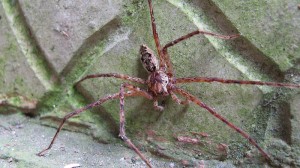
Click on Matthew B.’s photos to seem some photos
taken by him since the start of the course.
Return to classes, rodeo and cooking
Click on the photo to see a higher resolution image. Or click on Atenas & Classes, Rodeo, or Cooking Class. to see images with a similar theme.
We got back to classes on Monday morning, and in the evening we went to the rodeo that is part of the “Fiestas de Sabana Larga.” Sabana Larga is the name of area on the outskirts of Atenas where many of us are staying. On Tuesday evening the students split into 3 groups and each group cooked a typical meal in a different home under the guidance the homestay mother. Tomorrow afternoon after class we are going to tour some of the agricultural fields of Sabana Larga and learn some of its history.
Slippery when wet
We made it back to Atenas, and back to the now more familiar homestays and ¨tranquilo¨of this town after time in un ¨bosque lluvioso.¨ Our weekend trip marked our entry into the Science portion as we began to explore, observe and ask questions about the tropical ecosystem of the protected forest of La Reserva de San Ramon. To view some photos of time in La Reserva skip down to Steve´s entry.
We had quite an unique intro to the forest, and a true showing of the patience and care within the group over the weekend. Saturday we hiked through a steep trail and helped each other along the slippery climb. On Sunday morning, we worked together with the generous folk from the station, to bring Kaihla, who had tripped and cut her knee, back safely back across the river. Students helped with carrying her out along with the director and several station and volunteers.
Upon returning to the station, we organized the details to regroup with later, had a bite of lunch that was kindly prepared early for the group. Kaihla and I then traveled in a little 4×4 off-road ambulance driven by a team of the most hilarious EMT´s who kept us laughing along the way to the hospital in San Ramon for stitches. Students adjusted to the change in plans and returned to the field station and continued with their journal observations, making detailed drawings and trekking into the nearby part of the river for a soak. After lunch the group headed back down the muddy roads one truck load at a time, amusing themselves with with games and even some howler monkey sightings. The timing somehow worked out perfectly, just as the bus with the students showed up, Kaihla and I had completed the hospital visit. Back we headed to Atenas dropping students off at their homestays. Tomorrow we begin a more routine week of Spanish class in the morning and group activity in the afternoon. Tomorrow afternoon we are excited to welcome Sebastian, who will be flying in from the States to join up with our group.
To echo Steve´s sentiments, what a unique opportunity to be welcomed into the University of Costa Rica´s Reserva Biologica de San Ramon! This was an introduction to a tropical forest and the remote life of dedicated biologists, that is more ¨like the old days.¨ Many sites, which used to be remote research stations, have transformed a lot in the last 30 years with the tourist industry in Costa Rica, now offering manicured pathways and a more mediated connection with a forest. So being welcomed into a working research site as a high school group was a rare opportunity.
that´s some of the basic review from my point of view, (i hope we wil get some student entries soon to give another perspective!) and if you wish, read on for some more descriptive details of our time…
We left Atenas by bus and immediately began to experience the incredible shifting of micro-climates, zig zagged up and down the mountains, closing and opening the large bus windows to cool off or warm up. At one point the bus was engulfed in mist and we could barely see, and another point the view was clear and we could gaze far out across the rolling hills dotted with bare trees in full orange flowering blooms and fence posts sprouting green and yellow tufts of leaves. We met up with Juan Sanchez´s Cousin Sergio, a student of Natural Resource Management in San Ramon, and choose to buy more rubber boots after getting a better sense of what we are in for, and then continue on.
As we turned off the main road, the bus passes along the muddy carretera through the thick tunnel of trees with occasional openings for viveros (nurseries) that produce your ¨dentist´s office tropical greenery¨as some students comment. Then as the road gets muddier, we are met by the station director and pile in with our packs into two off-road camionetas (little trucks)…a luxury, the original researchers at this site, before the road, hiked in 5 hours. We held on tight to the truck wherever we could and bumped and slipped and slid until we arrived at the entrance with a sigh of relief.
After a nice warm lunch and settling in a bit to the dorm rooms we prepare for our first hike into the woods…it begins with a river crossing and we are armed with bamboo walking sticks to steady our way across the slippery rocks. We soon find out that staying dry may not be easy and water pours into our boots and beyond. The director Ronald gives us a briefing about what to watch out for, like snakes curled on the opposite side of a log as you step (luckily it is not snake season) and the multiple kinds of spiny trees, if you are about to fall, best to just let yourself fall than grab for the nearest tree and get a grip full of prickly spines. We dive up into two groups, one with a local biologist and and Juan´s cousin Sergio, and another with the director and off we go up and then down the steep single file looping trail, past bromeliads, heliconia, walking palms, tall ferns and epiphyte laden trees and the calls of hidden parrots.
In the evening set up a bat mist net and incandescent and black light to attract insects on a white sheet. We go back to check after dinner, and find one bat and the fair number of assorted large moths with various odd shapes, many mimicking the look of dried leaves or with bright white patches like eyes, and almost none of of them the same species. It is beginning to rain more, so there is less action then on more clear nights we are told. Same goes for the early morning bird mist net, we do end up capturing one small wren and take a stroll with the brave early morning risers to look for birds. We hear a lot, but have few sightings. But ¨asi es¨, this is how it is, life here in the forest is unpredictable, nothing is at our beck and call, there seems to be a patience and deep respect that comes with being a researcher in this field, and it was an amazing experience to get to participate in, if only for two days in this dream of these scientists. Ronald showed us pictures and shared with the group yesterday evening about how the station has grown from basically a little tent and small one room wooden structure in the woods with only a walking trail to the resource that is is now for scientists. He projects the next slide on the screen, a photo full of huge rocks and boulders, similar to those we were navigating along the river, he is describing how you just keep facing each obstacle, working together, until you overcome it, bit by bit, attend to what is needed. For over twenty years, as part of a team of researchers, Ronald has been studying the epidemiology of monkeys, comparing their DNA and the presence or absence of diseases that are similar to human diseases in populations of monkeys that live near cities and those in more remote areas.
It is hard to believe this is only our fourth night here… bueno, hasta luego….
Photos of “La Reserva”
Click on this link – La Reserva – or go to the photo gallery under important links to the right to see photos of our stay at Alberto Manuel Brenes Biological Reserve field staion (La Reserva)
Our stay at “La Reserva” was an adventure. It was very remote and the roads were very muddy. The trails were steep and slippery. (Amber will fill you in on a trial that Kaihla had.) Nevertheless, the students really enjoyed their stay, and we all very much appreciated the Costa Ricans working at this station. They have vision for this station and a passion to keep it going–despite little funding. This station is run by the University of Costa Rica, and they rarely host outside groups like ours. Juan Sanchez is largely responsible for us having the oppurtunity to visit this site. Thank you Juan!
A full day…or has it already been a week?
What a full first day! We are all doing well. By course standards we are right on schedule with all the spurts and starts and attention to multiple details that are demanded in orienting a group to a new place. We all made it through our first night with our homestays, getting our tongues wrapped around speaking Spanish and brains shifting into gear. Orange groves and a magnificent tree draped with epiphytes became the backdrop for our orientation to Atesa Spanish School. Believe it or not, we all arrived in perfect time to the school from our various homestays, some students met up in the center of town to take a taxi and others who live closer to the school walked along the main road in Sabana Larga. Mercedes, the director of the school, greeted us warmly and we gathered to share stories of our first night. We exchanged details of our new families and celebrated small victories of communication, like ¨having only one¨tu¨ mistake,¨as one student shared, that is, he only forgot once to use the¨usted¨ formal manner in Spanish of addressing his family instead of the informal expression¨tu¨- (He has a better record than me, I think I slipped ¨tu¨ in a couple times). Luckily our families seem very forgiving, generous and muy cariñoso (very loving).
(And since I am taking the liberty of writing about my impression of our experiences, you may notice I am not using names to protect the privacy of those who may not wish personal details posted for all to see!…I will wait for permission to fill them in…and on that note, forgive any misspellings since it is late)
As the day proceeded students had their mini ¨entrevistas¨so they could be placed with their Spanish groups while the teachers worked to align the schedule of the days to come and iron out all the little details that need to be communicated to all the families. From brief reports, sounds like the classes went really well for the first day, and I saw lots of smiles and observed the first coconut being dissected at break time. One student has fulfilled his goal of picking and eating a fruit from a tree…what next? Spearing fish was the answer..we shall see about that later.
And like clockwork, as seems to be expected on these trips, before noon we had our first case of ¨me siento un poco inferma¨(i feel a little sick)… as one student found herself a bit sick en el estomago. Luckily we were able to get her attention from the on call doctors and I am happy to report she is feeling much better, being pampered by her host mom with warm soothing broth and electrolytes from the local farmacia.
In the afternoon we met up in the center for a tour of Atenas. First stop, the bank, to change dollars to colones and next stop, a little cafe, to regroup and refresh. Here we ordered chocolate cake and tropical fruit smoothies or gaseosas (carbonated drinks) which helped calm the first day nerves, and gave us time to chat and figure out a plan to make sure everyone could find their homestay on their return walk or taxi ride. A couple students learned about how similar houses and streets around here can look with no street signs or house numbers. Which brought one of us to declare that our service project should be to paint street signs… while it may not help the Ticos, it sure would benefit the next group of Gringos!
Tomorrow we head to San Ramon, to visit a Biological Reserve that is part of the University of Costa Rica. There we have our first introduction to tropical forest ecology and we will stay overnight at the field station…we have been advised to wear rubber boots…we will report back how necessary this is, since some of us may tough it out with other foot gear.
The sounds outside my window, firecrackers and salsa music echoing off the hillside, from the fiesta de Sabana Larga are beginning to die down. This evening several of the students met up or went with their families to see the town festival. Strings of lights announcing the event hang across the main street to the entrance of the fairgrounds where there are horse shows, bull riding, dj dance halls, spinning rides (that may give some more group members a sick stomach) and plenty of comidas tipicas. The festival will go through Monday night, so we hope to return to take in more of this local favorite — full description of it may demand another novel…so I will spare you that now and get myself to bed. We have another full day planned for tomorrow…we should be back online by Sunday eve if any of us are awake enoguh to write…hasta luego.
Emergency Contact Number in Costa Rica
Kaihla has the cell phone that is our emergency contact number while in Costa Rica. To reach Kaihla dial: 011-506-88 91 16 38 I will post this in communications section now and delete this post in a couple days.
We have arrived in Atenas!
We had a safe and easy flight into San Jose. At the airport we met up with Maruja, one of the host parents, and her husband who helped us pile all our luggage and our slightly travel weary yet eager selves into their van. Then we took off towards Atenas, taking in all the new sights and smells and humid air. Quite a contrast to the Boston environment. We arrived in Atenas center and met up with Maria from the Spanish school who has organized the homestays for us. There we gathered for a brief orientation and made a plan to for everyone to get to school. And after last little reminders, like remember to throw toilet paper in the waste basket instead fo the bowl, we were ready to pile back into the van and begin the process of distributing us to homestay famlies. Each student’s famly was waiting to welcome them into to their home and we waved “hasta manana” as we left student by student and bag by bag, slowly carving through the mountains of the beautiful Atenas countryside and the mountains of luggage piled in the back of the van until we were all settled for our first night. Tomorrow we will meet at the school at 8am, learn more about Atenas and what to expect in the weeks to come. Each student will be matched up with a small group and a wonderful teacher and begin Spanish class, and then in the afternon we will have a tour of the town. More to come!
Hope all is well back in Boston!
We’re in the Miami Airport
We’re all in the airport waiting for our connecting flight to San José. There are have been no hitches and everyone seems to be doing well.

